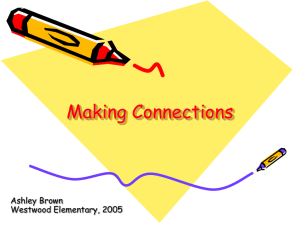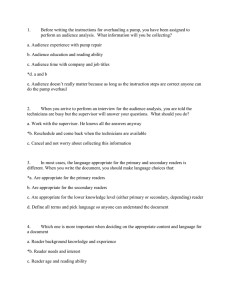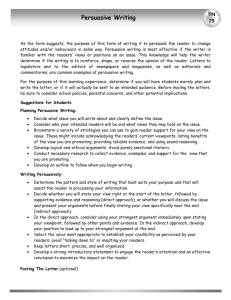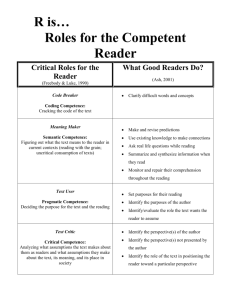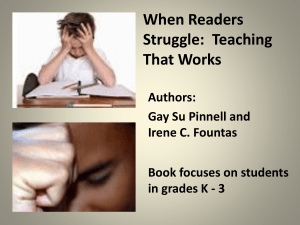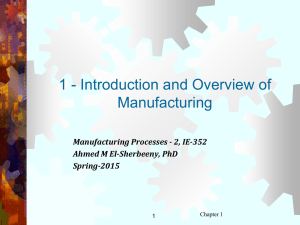The Reading Process - Shaping the Future Through Teaching and
advertisement
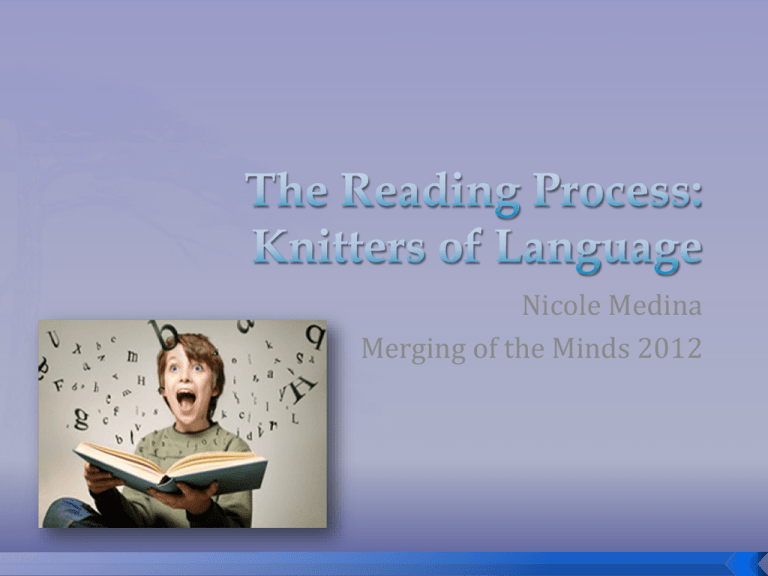
Nicole Medina Merging of the Minds 2012 Information + Thinking = Knowledge ~Stephanie Harvey, IRA 2012 “Read aloud is your pay-it-forward.” Creates schema Produces mentor texts for writing Models fluency Creates opportunities for speaking and listening ~Dr. Jan Burkins, IRA 2012 “Children first learn to listen and speak, then use these and other skills to explore reading and writing. Like child development in general, language development is interrelated. Children who have many opportunities to listen and speak tend to become skilled readers and writers. Children who can put their ideas in writing become better readers. Children who are read to often, learn to love reading and become better listeners, speakers, and writers.”! ~http://www2.ed.gov/pubs/RoadtoRead/part2.html Babies are born with 100 billion brain cells, called neurons – almost all they will ever have. Neurons are not yet connected into networks as they will be when the brain is mature. Connections are made as brain cells send signals to and receive input from each other. A single cell can connect with as many as 15,000 other cells. The resulting network of connections is called the brain’s wiring or circuitry. ~http://www2.ed.gov/pubs/RoadtoRead/part2.html Shortly after birth a baby’s brain produces trillions more connections between neurons than it can possibly use. By age 3, the child’s brain has formed 1,000 trillion connections – twice as many as in an adult brain. Beginning at about age 10, the child’s brain begins getting rid of the extra connections and gradually creates a more powerful and efficient circuitry. The brain permanently retains the connections that are used repeatedly in the early years and eliminates connections that are seldom or never used. The window for acquiring syntax may close as early as 5 or 6 years old – still possible to learn, but more difficult. ~http://www2.ed.gov/pubs/RoadtoRead/part2.html We’re putting our money on YOU! No workbook, worksheet, intervention, or PD can impact kids the special way that you can. Your understanding, and delivery of it, directly affects the success of the students in your classroom. Notice what strategies you use. Think about complexity (how hard it is, what kind of thinking do you have to do) Read the book. What did you notice? Print Story •Print •Alphabet •First letter •Content •Frustration •Peers-models •Letter similarities •Lower and upper case •Repetition •Patterning •Pictures •Structure •Predictions ~ Dr. Jan Burkins, IRA 2012 Print Dependent Print Story Meaning Dependent Print No Connection Issues & No Connection Print Print Story Story Story ~ Dr. Jan Burkins, IRA 2012 Print Story Meaning Does it make sense? Print Story Visual Structure Does it look right? Does it sound right? Print Story Print/Story Dependent? Pay-it-forward with Read Aloud Build on the known Teacher I do Modeled Instruction Shared Instruction We do Guided Practice Independent Practice Student You do together You do alone “Read like a writer.” “Write like a reader.” “In reading, meaning is build from texts and in composing, meaning is built for text” (Nelson, 1998, p. 279). Please choose an article about one of the following topics to read: Vocabulary Fluency Comprehension Text Complexity Be prepared to tell the group one ah-ha you had. Six Dimensions Fluency Rubric 1. Pausing The way the reader’s voice is guided by punctuation 2. Phrasing The way the readers put words together in groups to represent the meaningful units of sounds 3. Stress The emphasis readers place on particular words to reflect the meaning as speakers would do in oral language 4. Intonation The way the reader varies the voice in tone, pitch, and volume to reflect the meaning of the text – (aka expression) 5. Rate The pace at which a reader moves through the text – not too fast or too slow 6. Integration The way a reader consistently and evenly orchestrates rate, phrasing, pausing, intonation, and stress ~Fountas & Pinnell Benchmark Assessment System I “It is the skill that focuses the group, not the level.” ~ Gail Boushey and Joan Moser www.choiceliteracy.com “For everyone who has will be given more, and he will have an abundance. Whoever does not have, even what he has will be taken from him.” ~Matthew 29:25 The rich get richer, and the poor get poorer. Research indicates that past the 4th grade, literacy intervention and remediation programs are only successful with about 13% of struggling readers. Intelligence: Anderson and Freebody note that “the strong relationship between vocabulary and general intelligence is one of the most robust findings in the history of intelligence testing” (quoted in Marzano, 2004, p.32). Vocabulary scores correlate more highly with intelligence levels than any other individual measure. That’s why standardized tests such as the SAT, ACT, and GRE have a vocabulary component. Reading: Farley and Elmore studied college students enrolled in remedial reading. They found that vocabulary was the only statistically significant predictor of various reading skills. According to Fisher and Frey (2008), research confirms that “…students with smaller vocabularies and lower comprehension levels read with more trepidation, question the text less, and fail to notice when they don’t understand something” (p.4). Predictor of Academic Success: Reading comprehension has been repeatedly shown to be a good predictor of academic success at the high school and college levels. So the chain is complete: vocabulary is an excellent predictor of academic success. Vocabulary truly is at the center – not only of the ELA classroom, but in all of the content areas. ~Benjamin and Crow 2010 “Vocabulary, then, is to academic learning what cardiovascular strength is to fitness. And just as most people have to go out of their way to achieve cardiovascular fitness by working out (rather than relying on their ordinary activities to build sufficient strength), educators have to be deliberate and conscious about improving students’ vocabulary.” ~Benjamin and Crow 2010 A word is “…the label associated with a packet of knowledge stored in permanent memory.” These packets are what he refers to as background knowledge (aka schema). Research has consistently shown that definitional learning alone does not make a significant contribution to reading comprehension. ~Benjamin and Crow 2010 ~Robert Marzano in Building Background Knowledge for Academic Achievement Stand and walk over to someone else in the room. Face him or her. Tell him what you learned. Your partner will do the same. Then come back and write (for two minutes) what you learned from your partner. Rich and Varied Language Experiences Teach Individual Words Vocabulary Instruction Teach WordLearning Strategies Foster Word Consciousness Time of Day Instructional Activities Morning Meeting •Word-of-the day activities •Word-play activities Reading •Independent reading and writing •Read-alouds •Literature circles and literature response activities •Instruction in self-selected and teacher-selected words from books read or compositions being written •Mini-lessons on word-learning strategies •Teacher-student reading conference Content Areas •Instruction in specific subject-matter vocab •Word-learning strategy instruction integrated into socials studies/science lesson •Content-related read-alouds and trade book reading Writing •Mini-lessons on word-learning strategies •Teacher-student writing conference Tier 1: Basic words such as milk, smile, and jump. Rarely require instructional attention. Tier 2: Appear frequently in a wide variety of texts and provide mature language users with precise ways to refer to familiar ideas. Words such as darting, exceptional, and rummage are examples. Tier Two words represent the bulk of vocabulary instruction. These words need to be posted and kept in circulation so that students practice applying them in varied contexts over an extended period of time. Tier 3: Words such inlet, quadrilateral, and isotope. Typically emphasized as part of a thematic or content area instruction. Posting these words on a topic wall encourages their use when discussing or writing on specific topics. Qualitative: levels of meaning or purpose; structure; language conventionality and clarity; and knowledge demands Quantitative: word length or frequency, sentence length, and text cohesion, that are difficult if not impossible for a human reader to evaluate efficiently, especially in long texts, and are thus today typically measured by computer software (Lexile) Reader and Task: variables of particular readers (motivation, knowledge, and experiences) and to particular tasks (such as purpose and the complexity of the task assigned and the questions posed) “Read, read, read and write, write, write.” ~Ernest Gaines Benjamin, A. & Crow, J. (2010) Vocabulary at the Center . http://www.eyeoneducation.com/bookstore/client/client_pages/samplechapt ers/7124-9.pdf & http://www.eyeoneducation.com/bookstore/productdetails.cfm?sku=71249&title=vocabulary-at-the-center Boushey, G. & Moser, J (2009) The Daily CAFÉ Burkins, J.M. & Croft, M.M. (2010) Preventing Misguided Reading: New Strategies for Guided Reading Teachers http://www2.ed.gov/pubs/RoadtoRead/part2.html Fountas, I. & Pinnell, G.S. Benchmark Assessment System Graves, M. (2009) Essential Readings on Vocabulary Instruction Marzano, R. (2004) Building Background Knowledge for Academic Achievement Nelson, N.(1998). Reading and Writing Contextualized. In Nelson, N. & R. Calfee (Eds.). The Reading and Writing Connection (pp.266-285). The Ninety-Seventh Yearbook of the National Society for the Study of Education (Part II). Chicago, IL: The National Society for the Study of Education.




